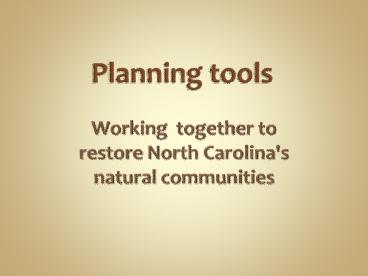Planning tools - PowerPoint PPT Presentation
Title:
Planning tools
Description:
EEP wants to do a better job creating natural ecosystems. CVS provides improved reference data, target design, monitoring, and data management and analysis CVS is ... – PowerPoint PPT presentation
Number of Views:66
Avg rating:3.0/5.0
Title: Planning tools
1
Planning tools
- Working together to restore North Carolina's
natural communities
2
EEP-CVS Collaboration
- EEP wants to do a better job creating natural
ecosystems. - CVS provides improved reference data, target
design, monitoring, and data management and
analysis
3
Where we are going
- CVS is developing tools and data sources to
facilitate planning of restoration activities and
to evaluate their success. - New data sources and tools are being designed
- Suggestions for new tools and increased
functionality are.
4
Restoration protocol
- Document reference conditions
- Derive restoration targets
- Design site-specific restoration plan
- Implement the plan
- Monitor change and assess success
- Employ adaptive management
5
Target generation
- Simple goal Deliver composition target based on
the vegetation type most appropriate for the site
and region. - Sophisticated goal Automated system that uses
site information and reference plot data to
predict vegetation composition.
6
Improving restoration targets
- Crude species lists
- Plot database linked to the National Vegetation
Classification and the Natural Heritage Program
documentation - High-resolution community classification with
quantitative descriptions. - Dynamically generated targets
7
Ecological Groups
- Mountain Vegetation
- Montane upland forests
- Montane open upland vegetation
- Montane alluvial wetland vegetation
- Montane nonalluvial wetland vegetation
- Piedmont Vegetation
- Piedmont upland forests
- Piedmont open upland vegetation
- Piedmont alluvial wetland vegetation
- Piedmont nonalluvial wetland vegetation
- Coastal Plain Vegetation
- Coastal Plain upland forests
- Coastal Plain upland open woodland vegetation
- Coastal Plain alluvial wetland vegetation
- Coastal Plain nonalluvial wetland vegetation
- Coastal Fringe Vegetation
- Maritime upland forests shrublands
- Maritime open upland vegetation
- Maritime nontidal wetland vegetation
http//cvs.bio.unc.edu
8
Community types linked to NVC
9
Description in the NVC
10
Primary sources of data
- Targeted communities
- Mountain bogs
- Piedmont alluvial forests
- Pulse events with regional focus
11
Plot map in pulse report
12
Classification table from Pulse
13
Community summary from Pulse
14
Compositon table from Pulse
15
Goal for the next yearDescriptive summaries,
keys, maps, species tables, site data, photos
where available
16
Example compositional summary
17
Example site summary
18
Example photo of type
19
Longleaf Pine vegetation
20
Xeric barrens Subxeric uplands Longleaf
turkey oak woodlands on entisols
9 Types13 Types
21
- Flatwoods
- Longleaf woodlands of spodosols
5 types
22
Silty uplands Longleaf woodlands on
well-drained ultisols
12 types
23
Savannas and seeps Longleaf woodlands on moist
alfisols
13 types
24
- Longleaf pine feasibility study
- Few longleaf pine sites remain in original
condition. - Restoration targets must be extrapolated from a
limited number of reference stands.
25
- Dataset
- 188 plots across fall-line sandhills of NC, SC,
GA - - All sites contained near-natural,
fire-maintained groundlayer vegetation - - Soil attributes included for both the A and B
horizon sand, silt, clay, Ca, Mg, K, P, S, Mn,
Na, Cu, Zn, Fe, BD, pH, organic content, CEC, BS.
26
Step 1. Classification. Developed a
classification of the major vegetation types of
the ecoregion. Used cluster analysis with a
matrix of 188 plots x 619 species. Vegetation
types were seen to be differentiated with respect
to soil texture, moisture, nutrient status,
geography.
27
- Step 2. Build model.
- - Forward selection with linear discriminant
analysis identified predictor variables. - Critical variables were Latitude, Manganese,
Phosphorus, Clay, Longitude. - 75 of plots correctly identified to vegetation
series. Typically 75 of plots within a series
were correctly classified to community type.
28
- Step 3. Select species.
- Generate a list of all species in type (species
pool) with frequency, mean cover values, and mean
richness. - Randomly order the list
- Compare species frequency to random number
between 0 1, and if the random number is less
than the proportion of plots the species is
selected. Continue until the number in list of
selected species equals the number predicted.
29
- Summary of overall strategy
- Identify biogeographic region and obtain
predictive models. - Select pool of candidate species for a specific
site based on range information. - Divide restoration site into environmentally
homogenous areas, stratifying by topography and
soil. - Use models to select species number and
composition.
30
Looking forward to continued collaboration































